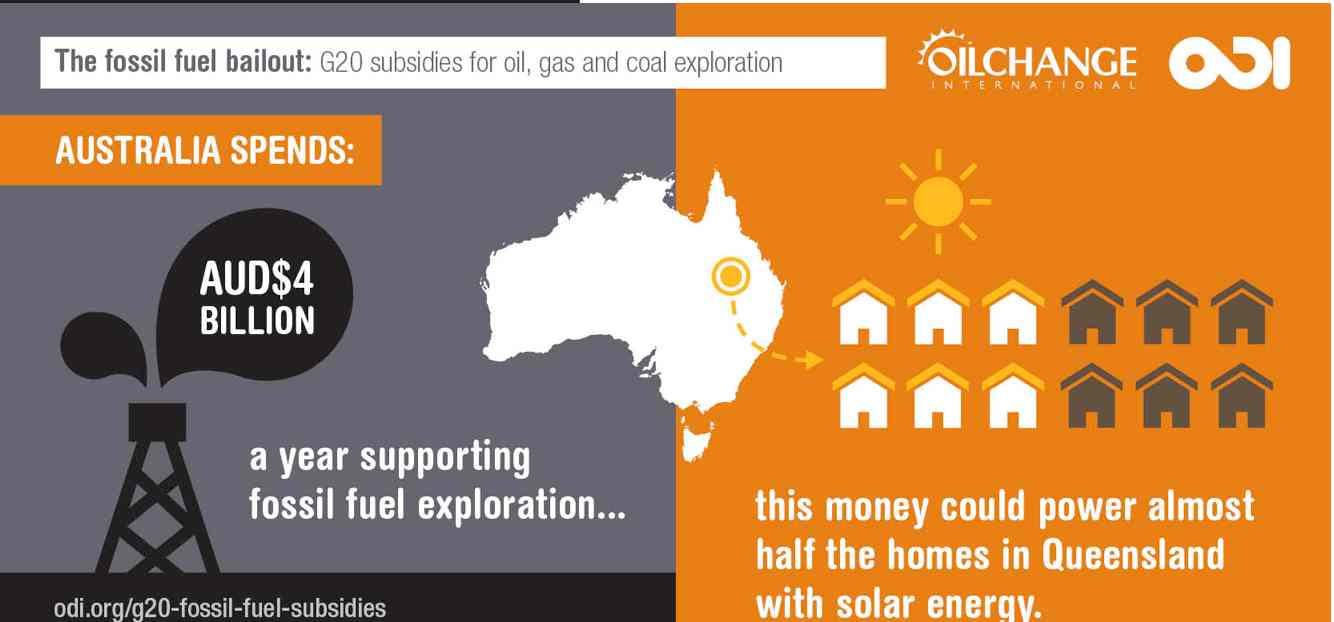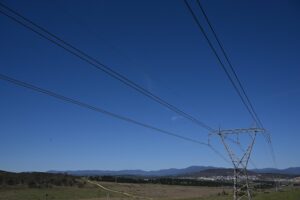A new study has found that G20 nations, including Australia, are providing $US88 billion ($A102 billion) a year in subsidies just for fossil fuel exploration, despite vowing five years ago to phase out such support.
Australia features prominently in the report, accounting for $US3.5 billion ($A4.05 billion) of the subsidies. These are for fossil fuel exploration in increasingly remote areas (offshore and inland) for projects that depend significantly on the provision of public infrastructure.
The report “The fossil fuel bailout: G20 subsidies for oil, gas and coal exploration” was prepared ahead of next week’s G20 meting in Brisbane, where climate change has been relegated to a “discussion point” and is not on the official agenda, and where major fossil fuel companies are expected to argue the case for yet more subsidies.
Tony Abbott agrees with them, saying coal is the “energy of the future.”
But the report by the London-based Overseas Development Institute and the Oil Change Institute slams this investment as a “double folly” – saying that the investment in new fossil fuel exploration is both uneconomic and unsustainable.
“Despite the widespread perception that renewables are costly, our research reveals that finding new fossil fuel reserves at home and abroad is costing Australian tax-payers $A4 billion a year,” Oil Change International’s Director Stephen Kretzmann said.
“Scrapping these fossil fuel exploration subsidies would begin to create a level playing field between renewables and fossil fuel energy.
“Five years ago, Australia and other G20 governments pledged to both phase out fossil fuel subsidies and take action to limit climate change. Immediately ending exploration subsidies is the clearest next step on both fronts.”
Many of the subsidies have been directed at reserves and resources that cannot be exploited at current market prices (unless, of course, they get more subsidies to exploit it).
And even if they did exploit it, it would create more high-carbon assets that would blow the world’s carbon budget and help create catastrophic climate effects.
And the subsidies are diverting investment from economic low-carbon alternatives such as solar, wind and hydro-power. And they are undermining the prospects for an ambitious climate deal in 2015.
But these subsidies – for finding new reserves of oil, gas, and coal – are just a fraction of the subsidies paid for fossil fuels production and use, which totalled $US775 billion in 2012, compared to just $US101 billon in subsidies for renewable energy in 2013.
This is despite the fact that renewable energy subsidies created $2.50 of investment for every dollar in subsidy, compared to just $1.30 in investment for every $1 in fossil fuel subsidies, underlying how reliant fossil fuels are on state and other subsidies.
Despite the issue of “unburnable carbon” and the threat of stranded assets, fossil fuel companies are continuing to invest heavily in exploration, spending $US674 billion in 2012 alone in the search for new oil, gas and coal resources .
This is despite the fact that more than half of the oil industry needs crude oil prices of $US120/barrel to generate “free cash flow”.
The oil price is currently in the low $US80/barrel. US oil prices are below $US80/barrel, and some investment banks are warning of “energy price deflation” because of the growing impact of solar. In other words, the conventional view that oil prices will always recover no longer applies.
The same thing is happening in coal. Demand for coal is slowing, and prices have fallen to their lowest level since 2009. Almost two-thirds of greenfield coal mines, the report says, are not economic at today’s prices. As RenewEconomy pointed out last week, the results of energy auctions in India have resulted in solar being produced at a cost well below that required to make the importing of coal from Australian economic.
“Without government support for exploration and wider fossil fuel subsidies, large swathes of today’s fossil fuel development would be unprofitable,” the report says.
“Directing public finance and consumer spending towards a sector that is uneconomic, as well as unsustainable, represents a double folly.”
The $A102 billion total subsidy on exploration is almost double the amount of financing the International Energy Agency (IEA) estimates is needed to achieve universal access to energy by 2030. Very little – around one per cent – of public financing of fossil fuels is going to areas where the grid currently does not reach.
In parallel with the rising costs of fossil fuel exploration and production, the costs of renewable-energy technologies continue to fall rapidly, and the speed of growth in installed capacity of renewables has outperformed predictions, the report notes.
Average solar PV module prices alone have fallen by nearly 75 per cent in the past three years, and wind and solar power are already price- competitive with fossil fuels in markets including in parts of the US and Australia.
Citigroup estimates that solar power alone (without subsidies) has already reached grid parity in Germany, Italy, Spain, Portugal, Australia and the US southwest, and that Japan will reach that point this year, Korea in 2018 and the UK in 2020.
And the IEA estimates that in order to stay below the 2°C limit, the share of renewables must increase to 65-80 per cent of global electricity production by 2050. In 2013, total investment in renewable energy was only $US250 billion, which contrasts sharply with the over $US1 trillion in fossil fuel energy investment.









